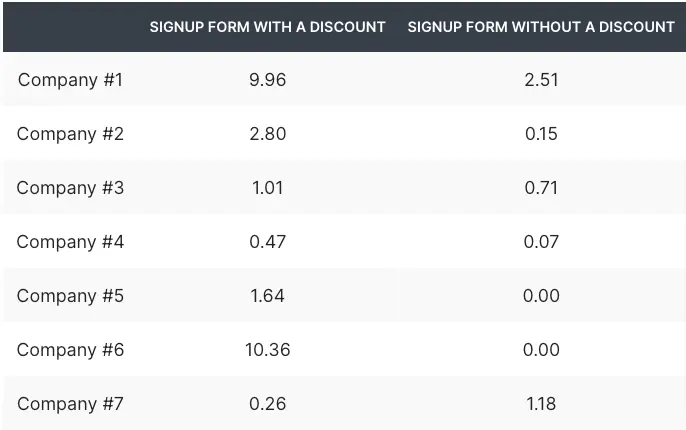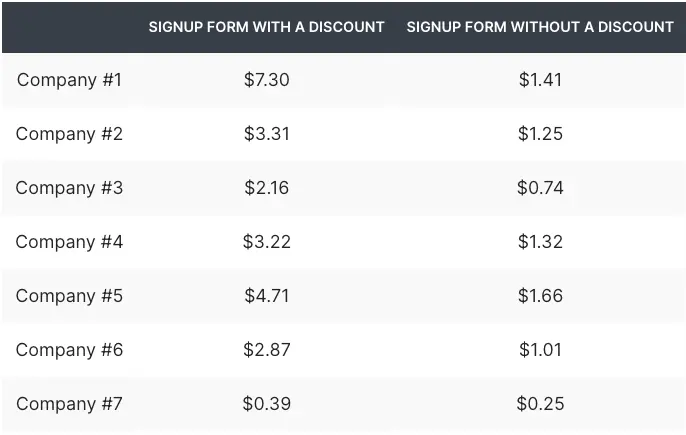Unsure about offering discounts on your signup forms? Let data put you at ease
Offering a discount in your signup form is a tactic some marketers say is a must.
If you’ve been toying with the idea of adding a discount to your signup form but the uncertainty of how your audience will respond is holding you back, then Klaviyo’s data science team has some insights that’ll ease your worries.
It can be stressful trying to make key decisions about the best ways to connect with your potential customers. Someone may interact with your online store through your signup form, so making changes to your forms can impact their decision to engage with your brand.
Offering a discount in your signup form is a tactic some marketers say is a must. Others are hesitant because they fear it only incentivizes bargain hunters to buy once, not repeatedly.
Klaviyo recently conducted an analysis of 7 companies that A/B tested the impact of offering a discount or not on their signup forms, the results of which you can find in your marketing reporting tool. While every company is unique, the data-backed insights from this analysis can help inform your own decisions.
Signup form discounts can help you get new customers
After you get a potential customer to your site, how can you convince them to engage with your business and sign up for your marketing communications? By offering them something in return for their information, like a discount.
Data validation:
When investigating the differences between signup form rates, researchers on Klaviyo’s data science team found, on average, signup forms with discounts had 90% higher subscription rates.
Signup form subscription rates:

Getting your site visitors to take that first step and subscribe to your list is important. It influences their experience with your brand, and it’s also an essential way to help you build your list of subscribers.
And that’s a good thing. The more subscribers you have, the more chances you have to build relationships that turn browsers into buyers and one-time buyers into repeat customers.
Discounts can increase initial and repeat conversions
A common concern brands have about offering discounts on their signup forms is that the people who sign up for their list may be less likely to turn into repeat customers. Klaviyo’s analysis showed this isn’t the case.
Data validation:
People who view a signup form with a discount are 190% more likely to make an initial purchase than those who view a signup form without a discount.
Number of customers who made a purchase per 10,000 form views:

Plus, in 6 of the 7 tests conducted, the signup form with a discount saw more repeat customers per form view.
On average, the signup forms that didn’t have a discount had less than 1 repeat customer per 10,000 views, while the signup forms with a discount had almost 4.
Number of customers who made a second purchase per 10,000 form views:

In this study alone, repeat customers made up 61% of the total revenue from the people who signed up, even though they only made up 41% of the total customer base—showing that repeat customers are the lifeblood of many businesses, and it’s worthwhile testing out strategies that’ll boost the number of loyal customers you have.
Discount signup forms generate more long-term revenue
Part of the uncertainty of trying something new is worrying about how it will affect you long term.
Data validation:
Well here’s some good news: Signup forms with a discount generated almost 200% more revenue per view than signup forms without an offer.
Revenue per view is: total $ spent by customers since signing up via a form divided by the number of views that form received.
Increasing your long-term revenue can help you operate your business at scale and grow efficiently.
Revenue per view:

To understand why revenue per view is so much higher for signup forms with a discount, you can look at two numbers: subscription rates and the total revenue per sign up.
As I mentioned earlier, subscription rates for signup forms with a discount are much higher than forms without ones. That difference though only explains a portion of why signup forms with discounts have a higher revenue per view.
Revenue per sign ups also plays a role.
Average revenue per sign up is: total $ spent by customers since signing up via a form divided by the number of signups that form received.
The average revenue generated per sign up for Klaviyo’s signup forms with a discount was 60% higher than ones without a discount—which matches conventional findings that demonstrate customers will spend more money when they feel like they are getting a deal.
Revenue per sign up:

One thing to keep in mind about this analysis is Klaviyo’s data science team didn’t factor in the total amount of discounts applied to purchases.
For example, some customers may have spent $1,000 total, with a $200 discount applied, meaning the original price of the products was $1,200. Other customers who signed up via a different form may have spent $500 total, but only had $5 in discounts, meaning the original price of the products was $505.
While these tests show that using discounts on your signup forms can help you grow your long-term revenue, it’s important to know how much of a discount you can offer and still remain profitable—try out a discount amount that makes sense for your business and the price of your products.
Experiment with offering a discount on your signup forms
Each of the companies in this analysis had a large sample size of different signup forms which allowed Klaviyo’s data science team to dive into how the use of discounts on a signup form can change the behavior of customers.
The tests paid off. Each company in Klaviyo’s analysis found a strategy that increased their list size, number of new and repeat customers, and revenue. You can too. What are you waiting for?

Related content

Achieve more in 3 months with Klaviyo Marketing Analytics. This calendar gives you the structure and documentation you need to level up.

Discover 6 data-driven ways to use Klaviyo Marketing Analytics to boost BFCM performance, personalize campaigns, and drive long-term customer retention.

Use this quick customer lifetime value formula to understand your business health and customer experience.